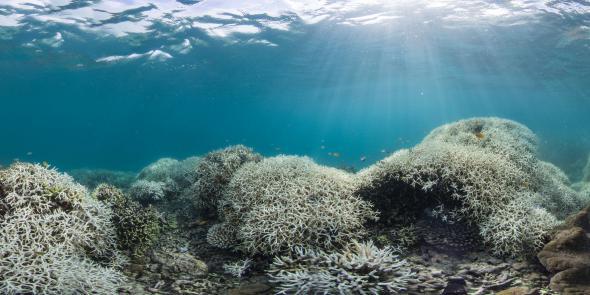Australia’s Great Barrier Reef is currently undergoing its most severe coral bleaching episode in recorded history, new data and images show. Bleaching occurs when water temperatures rise too much and corals defensively expel the symbiotic and colorful algae that helps them survive.
Results from a scientific aerial survey currently underway indicate that more than 40 percent of the 2300 km (1430 mi)–long reef system has been damaged by bleaching over the past several weeks. In the northern section where it is the worst, bleaching rates have hit 95 percent, with just 4 of the 520 reefs surveyed so far remaining healthy.
Scientists who have dedicated their careers to studying the reef and its ecosystem say the current bleaching is unprecedented, and perhaps unrecoverable. The emotion in their responses so far has been palpable.
“I witnessed a sight underwater that no marine biologist, and no person with a love and appreciation for the natural world for that matter, wants to see,” said Australian coral scientist Jodie Rummer in a statement, after spending more than a month at a monitoring station in the Great Barrier Reef.
Though corals comprise only about 0.2 percent of the global oceans, they support perhaps a quarter of all marine species. There’s about 400 years of coral growth rings in the Great Barrier Reef, though no evidence of widespread bleaching before 1998. The current bleaching is the third major episode since then, and the worst yet—driven by the record-setting El Niño and steadily increasing ocean temperatures triggered by human-caused climate change.
“What we’re seeing now is unequivocally to do with climate change,” Justin Marshall, a reef scientist from the University of Queensland, told the Australian Broadcasting Corporation. Nick Heath, a representative of the World Wildlife Fund in Brisbane, Australia, lamented that “we have been so complacent on this issue for so long” in an interview with the Australian Broadcasting Corporation. He added that he hopes the current mass bleaching would “trigger us out of our complacency.”
“This will change the Great Barrier Reef forever,” Terry Hughes, the Australian coral scientist who has been conducting the aerial survey, told the Australian Broadcasting Corporation. Hughes said the bleaching was his “worst nightmare” and expects about half the affected coral to die in the coming months. “This has been the saddest research trip of my life,” he said in a statement. More than sadness, though, Hughes said he feels anger at the Australian government, who he thinks should have acted sooner to prevent the current situation.
For their part, the Great Barrier Reef Marine Park Authority, the governmental body responsible for protecting the reef through restrictions on fishing, coastal development, and other commercial activity, has elevated its bleaching alert to the highest level, which will allow for ramped up monitoring over the coming months. Greg Hunt, the divisive Australian Minister for the Environment, who has advocated funding cuts for climate science, downplayed the role of climate change in the bleaching. In 2015, Hunt approved a major expansion of an existing coal port adjacent to the reef that would require potentially damaging dredging near the reef.
Coral bleaching has long been considered one of the most certain consequences of climate change. While a bleached reef appears dead, it can recover if water temperatures fall quickly enough to allow the expelled algae to recolonize the reef. If that doesn’t happen, the affected corals may still recover by rebuilding the reef entirely, but that process could take decades or longer. Problem is, given global warming, bleaching events are occurring more rapidly, and corals don’t have a chance to adequately recover before the problematic conditions happen again. There are scientists working to speed up the reef’s recovery time, including Hawaii-based Ruth Gates, who is using a technique known as “assisted evolution” to try to breed more resilient coral species. There are also emerging coral-farming techniques, in which lab-grown corals could be transplanted back into the wild. In virtually all climate change scenarios, annual coral bleaching will approach 100 percent within the next 60 years or so, but more rapid carbon-emission cuts at the global level may buy these techniques a few more decades to improve corals’ survival chances.
The current bleaching episode isn’t just confined to Australian waters—corals worldwide are suffering from what’s become the longest-lasting global bleaching event on record. Kim Cobb, a coral scientist at Georgia Tech University, departed on Monday for Kiritimati (Christmas Island), an atoll that is part of the Republic of Kiribati, where she will conduct an assessment of the reefs there.* On Twitter, she said she was “not emotionally prepared” for what she’ll find when she arrives. Last weekend, her colleague Danielle Claar said even pristine sites there now have about 75 percent mortality. Data points like these are coming in from all over the world.
Coral reefs are canaries in the coal mine of climate change: Their visually obvious reaction to warming waters indicate that the changes currently happening are serious, and have impacts that reverberate beyond what we can see, too. Coral bleaching and record-low Arctic sea ice are leading indicators that we’re rapidly leaving behind the stable climate we’ve enjoyed for the last few million years. If the loss of the Great Barrier Reef doesn’t shock us into action, I’m not sure what will.

XL Catlin Seaview Survey
Correction, March 30, 2016: A previous version of this post incorrectly referenced the location of Christmas Island, where coral reef studies are taking place. There are actually two Christmas Islands: one is a territory of Australia in the Indian Ocean, the other is part of the Republic of Kiribati, south of Hawaii. The coral reef studies are taking place in the latter.
